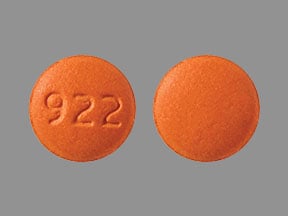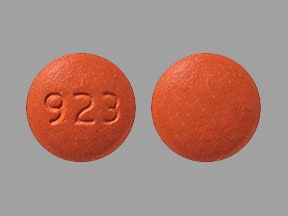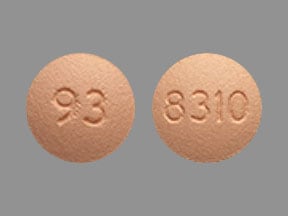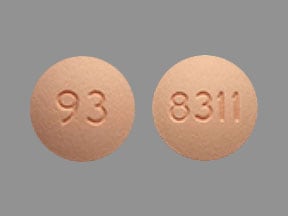Dosage Forms
Excipient information presented when available (limited, particularly for generics); consult specific product labeling.
Tablet, Oral:
Relpax: 20 mg
Relpax: 40 mg [contains fd&c yellow #6 aluminum lake]
Generic: 20 mg, 40 mg
Pharmacology
Mechanism of Action
Selective agonist for serotonin (5-HT1B, 5-HT1D, and 5-HT1F receptors) in cranial arteries; causes vasoconstriction and reduces sterile inflammation associated with antidromic neuronal transmission correlating with relief of migraine
Pharmacokinetics/Pharmacodynamics
Absorption
Well absorbed
Distribution
Vd: 138 L
Metabolism
Hepatic via CYP3A4; forms one metabolite (active)
Time to Peak
Plasma: 1.5 to 2 hours
Half-Life Elimination
~4 hours (Elderly: 4.4 to 5.7 hours); Metabolite: ~13 hours
Protein Binding
~85%
Use in Specific Populations
Special Populations: Renal Function Impairment
BP elevations were observed.
Special Populations: Hepatic Function Impairment
Mild to moderate impairment results in an increase in both AUC (34%) and half-life, and Cmax increased 18%.
Special Populations: Elderly
Increased half-life from approximately 4.4 to 5.7 hours in elderly patients (65 to 93 years of age).
Special Populations: Race
Japanese men had a 35% reduction in eletriptan exposure.
Use: Labeled Indications
Migraines: Acute treatment of migraine, with or without aura in adults
Contraindications
Ischemic coronary artery disease (eg, angina pectoris, history of myocardial infarction, documented silent ischemia); coronary artery vasospasm, including Prinzmetal angina; Wolff-Parkinson-White syndrome or arrhythmias associated with other cardiac accessory conduction pathway disorders; history of stroke, transient ischemic attack, or history or current evidence of hemiplegic or basilar migraine; peripheral vascular disease; ischemic bowel disease; uncontrolled hypertension; recent use (within 24 hours) of treatment with another 5-HT1 agonist, or an ergotamine-containing or ergot-type medication (eg, dihydroergotamine or methysergide); recent use (within at least 72 hours) of the following potent CYP3A4 inhibitors: ketoconazole, itraconazole, nefazodone, troleandomycin, clarithromycin, ritonavir, or nelfinavir; known hypersensitivity to eletriptan or any component of the formulation.
Canadian labeling: Additional contraindications (not in US labeling): Cardiac arrhythmias (especially tachycardias), valvular heart disease, congenital heart disease, atherosclerotic disease; ophthalmoplegic migraine; Raynaud syndrome; severe hepatic impairment.
Documentation of allergenic cross-reactivity for serotonin 5-HT1 receptor agonists (triptans) in this class is limited. However, because of similarities in chemical structure and/or pharmacologic actions, the possibility of cross-sensitivity cannot be ruled out with certainty.
Dosage and Administration
Dosing: Adult
Note: If the first dose is ineffective, diagnosis needs to be re-evaluated. Safety of treating >3 headaches/month has not been established.
Acute migraine: Oral: Initial: 20 to 40 mg as a single dose (maximum: 40 mg/dose); if the headache improves but returns, dose may be repeated after 2 hours have elapsed since first dose (maximum: 80 mg/day). Note: 80 mg single doses have been evaluated in clinical trials, however this dose has been associated with a slightly greater incidence of adverse reactions (McCormack 2006).
Dosing: Geriatric
Refer to adult dosing.
Administration
Administer orally as soon as symptoms appear. May take with or without food.
Storage
Store at 20°C to 25°C (68°F to 77°F); excursions are permitted between 15°C and 30°C (59°F and 86°F).
Eletriptan Images
Drug Interactions
Clofazimine: May increase the serum concentration of CYP3A4 Substrates (High risk with Inhibitors). Monitor therapy
Conivaptan: May increase the serum concentration of CYP3A4 Substrates (High risk with Inhibitors). Avoid combination
CYP3A4 Inhibitors (Moderate): May increase the serum concentration of Eletriptan. Management: The use of eletriptan within 72 hours of a moderate CYP3A4 inhibitor should be avoided. Consider therapy modification
CYP3A4 Inhibitors (Strong): May increase the serum concentration of Eletriptan. Exceptions: Nefazodone. Avoid combination
Droxidopa: Serotonin 5-HT1D Receptor Agonists (Triptans) may enhance the hypertensive effect of Droxidopa. Monitor therapy
Erdafitinib: May increase the serum concentration of CYP3A4 Substrates (High risk with Inhibitors). Monitor therapy
Ergot Derivatives: May enhance the vasoconstricting effect of Serotonin 5-HT1D Receptor Agonists (Triptans). Serotonin 5-HT1D Receptor Agonists (Triptans) may enhance the vasoconstricting effect of Ergot Derivatives. Exceptions: Nicergoline. Avoid combination
Fosaprepitant: May increase the serum concentration of CYP3A4 Substrates (High risk with Inhibitors). Monitor therapy
Fusidic Acid (Systemic): May increase the serum concentration of CYP3A4 Substrates (High risk with Inhibitors). Avoid combination
Idelalisib: May increase the serum concentration of CYP3A4 Substrates (High risk with Inhibitors). Avoid combination
Larotrectinib: May increase the serum concentration of CYP3A4 Substrates (High risk with Inhibitors). Monitor therapy
Monoamine Oxidase Inhibitors: Serotonin 5-HT1D Receptor Agonists (Triptans) may enhance the serotonergic effect of Monoamine Oxidase Inhibitors. This could result in serotonin syndrome. Monoamine Oxidase Inhibitors may increase the serum concentration of Serotonin 5-HT1D Receptor Agonists (Triptans). Exceptions: Rasagiline; Safinamide; Selegiline. Avoid combination
Nefazodone: Eletriptan may enhance the serotonergic effect of Nefazodone. This could result in serotonin syndrome. Nefazodone may increase the serum concentration of Eletriptan. Avoid combination
Palbociclib: May increase the serum concentration of CYP3A4 Substrates (High risk with Inhibitors). Monitor therapy
Serotonergic Agents (High Risk): Eletriptan may enhance the serotonergic effect of Serotonergic Agents (High Risk). This could result in serotonin syndrome. Management: Monitor for signs and symptoms of serotonin syndrome/serotonin toxicity (eg, hyperreflexia, clonus, hyperthermia, diaphoresis, tremor, autonomic instability, mental status changes) when these agents are combined. Exceptions: Isocarboxazid; Linezolid; Methylene Blue; Moclobemide; Nefazodone; Phenelzine; Tranylcypromine. Monitor therapy
Simeprevir: May increase the serum concentration of CYP3A4 Substrates (High risk with Inhibitors). Monitor therapy
Stiripentol: May increase the serum concentration of CYP3A4 Substrates (High risk with Inhibitors). Management: Use of stiripentol with CYP3A4 substrates that are considered to have a narrow therapeutic index should be avoided due to the increased risk for adverse effects and toxicity. Any CYP3A4 substrate used with stiripentol requires closer monitoring. Consider therapy modification
SUMAtriptan: Serotonin 5-HT1D Receptor Agonists (Triptans) may enhance the adverse/toxic effect of SUMAtriptan. Avoid combination
Adverse Reactions
1% to 10%:
Cardiovascular: Chest pain (2% to 4%; chest tightness, pain, and pressure), palpitations
Central nervous system: Dizziness (6% to 7%), drowsiness (6% to 7%), headache (4%), paresthesia (3% to 4%), chills, hypertonia, hypoesthesia, pain, vertigo
Dermatologic: Diaphoresis
Gastrointestinal: Nausea (8%), xerostomia (3% to 4%), abdominal pain (2%; pain, discomfort, stomach pain, cramps, and pressure), dyspepsia (2%), dysphagia (1% to 2%)
Neuromuscular & skeletal: Weakness (4% to 10%), back pain
Respiratory: Pharyngitis
<1%, postmarketing, and/or case reports (limited to important or life-threatening): Abnormal dreams, abnormal hepatic function tests, agitation, alopecia, amnesia, anaphylactoid reaction, anaphylaxis, anemia, angina pectoris, angioedema, aphasia, ataxia, cardiac arrhythmia, confusion, constipation, depersonalization, depression, diarrhea, diplopia, dysgeusia, dyspnea, dystonia, edema, emotional lability, esophagitis, euphoria, gingivitis, hallucination, hyperesthesia, hyperglycemia, hyperkinesia, hypersensitivity reaction, hypertension, impotence, increased creatine phosphokinase, insomnia, ischemic colitis, lacrimation, manic behavior, myalgia, myasthenia, myocardial infarction, nervousness, paralysis, peripheral edema, peripheral vascular disorder, photophobia, polyuria, Prinzmetal angina, pruritus, purpura, seizure, sensation of pressure (chest/neck/throat/jaw), shock, sialorrhea, skin discoloration, skin rash, speech disturbance, stupor, syncope, tachycardia, thrombophlebitis, tinnitus, tongue edema, tremor, twitching, urinary frequency, urticaria, vasospasm, ventricular fibrillation, visual disturbance, vomiting
Warnings/Precautions
Concerns related to adverse effects:
- Anaphylactic/Anaphylactoid reactions: Anaphylaxis, anaphylactoid, and hypersensitivity reactions (including angioedema) have occurred; may be life-threatening or fatal. Use is contraindicated in patients with known hypersensitivity to eletriptan.
- Cardiac events: Coronary artery vasospasm, transient ischemia, myocardial infarction, ventricular tachycardia/fibrillation, cardiac arrest, and death have been reported with 5-HT1 agonist administration; some events have occurred within a few hours of administration. Patients who experience sensations of chest pain/pressure/tightness or symptoms suggestive of angina following dosing should be evaluated for coronary artery disease or Prinzmetal angina before receiving additional doses; if dosing is resumed and similar symptoms recur, monitor with ECG. Use is contraindicated in patients with ischemic or vasospastic CAD and Wolff-Parkinson-White syndrome or arrhythmias associated with other cardiac accessory conduction pathway disorders.
- Cerebrovascular events: Cerebral/subarachnoid hemorrhage and stroke (some fatal) have been reported with 5-HT1 agonist administration. Use is contraindicated in patients with a history of stroke or transient ischemic attack.
- Elevated blood pressure: Significant elevation in blood pressure, including hypertensive crisis with acute impairment of organ systems, has also been reported on rare occasions in patients with and without a history of hypertension. Monitor blood pressure; use is contraindicated in patients with uncontrolled hypertension.
- Serotonin syndrome: Symptoms of agitation, confusion, hallucinations, hyper-reflexia, myoclonus, shivering, and tachycardia may rarely occur with concomitant proserotonergic drugs (ie, SSRIs/SNRIs or triptans) or agents which reduce eletriptan's metabolism. Concurrent use of serotonin precursors (eg, tryptophan) is not recommended. If concomitant administration with SSRIs is warranted, monitor closely, especially at initiation and with dose increases. Discontinue eletriptan if serotonin syndrome is suspected.
- Vasospasm-related events: Peripheral vascular ischemia, gastrointestinal vascular ischemia/infarction, and Raynaud syndrome have been reported with 5-HT1 agonists.
Disease-related concerns:
- Coronary artery disease: Should not be given to patients who have risk factors for CAD (eg, hypertension, hypercholesterolemia, smoker, obesity, diabetes, strong family history of CAD, menopause, male >40 years of age) without adequate cardiac evaluation. Patients with suspected CAD should have cardiovascular evaluation to rule out CAD before considering use; if cardiovascular evaluation is “satisfactory,” first dose should be given in the healthcare provider's office (consider ECG monitoring). Periodic evaluation of cardiovascular status should be done in all patients.
- Hepatic impairment: Not recommended for use in patients with severe hepatic impairment.
Concurrent drug therapy issues:
- Drug-drug interactions: Potentially significant interactions may exist, requiring dose or frequency adjustment, additional monitoring, and/or selection of alternative therapy. Consult drug interactions database for more detailed information.
Other warnings/precautions:
- Appropriate use: Only indicated for treatment of acute migraine; not indicated for migraine prophylaxis, or for the treatment of cluster headache, hemiplegic or basilar migraine. If a patient does not respond to the first dose, the diagnosis of migraine should be reconsidered; rule out underlying neurologic disease in patients with atypical headache and in patients with no prior history of migraine. Acute migraine agents (eg, triptans, opioids, ergotamine, or a combination of the agents) used for 10 or more days per month may lead to worsening of headaches (medication overuse headache); withdrawal treatment may be necessary in the setting of overuse.
Special populations:
- Elderly: Blood pressure was increased to a greater extent in elderly subjects than in younger subjects.
Monitoring Parameters
Headache severity; signs/symptoms suggestive of angina; blood pressure, heart rate, and/or ECG with first dose in patients with likelihood of unrecognized coronary disease, such as patients with significant hypertension, hypercholesterolemia, obese patients, patients with diabetes, smokers with other risk factors or strong family history of coronary artery disease; signs/symptoms of serotonin syndrome and hypersensitivity reactions
Pregnancy
Pregnancy Risk Factor
C
Pregnancy Considerations
Adverse events were observed in animal reproduction studies. Information related to eletriptan use in pregnancy is limited (Källén 2011; Nezvalová-Henriksen, 2010; Nezvalová-Henriksen 2012). Until additional information is available, other agents are preferred for the initial treatment of migraine in pregnancy (Da Silva 2012; MacGregor 2012; Williams 2012).
Patient Education
What is this drug used for?
- It is used to treat migraine headaches.
Frequently reported side effects of this drug
- Loss of strength and energy
- Fatigue
Other side effects of this drug: Talk with your doctor right away if you have any of these signs of:
- Severe nausea
- Vomiting
- Severe or persistent headache
- Severe dizziness
- Passing out
- Vision changes
- Constipation
- Diarrhea
- Severe abdominal pain
- Bloody stools
- Burning or numbness feeling
- Weight loss
- Leg cramps
- Sensation of heaviness or tightness in legs
- Sensation of cold
- Burning or pain in feet or toes
- Blue/gray skin discoloration
- Serotonin syndrome like dizziness, severe headache, agitation, sensing things that seem real but are not, fast heartbeat, abnormal heartbeat, flushing, tremors, sweating a lot, change in balance, severe nausea, or severe diarrhea.
- Severe cardiac abnormalities like chest, throat, neck, or jaw tightness, pain, pressure, or heaviness; break out in a cold sweat; shortness of breath; fast heartbeat; abnormal heartbeat; or severe dizziness or passing out.
- Severe cerebrovascular disease like change in strength on one side is greater than the other, difficulty speaking or thinking, change in balance, or vision changes.
- Signs of a significant reaction like wheezing; chest tightness; fever; itching; bad cough; blue skin color; seizures; or swelling of face, lips, tongue, or throat.
Note: This is not a comprehensive list of all side effects. Talk to your doctor if you have questions.
Consumer Information Use and Disclaimer: This information should not be used to decide whether or not to take this medicine or any other medicine. Only the healthcare provider has the knowledge and training to decide which medicines are right for a specific patient. This information does not endorse any medicine as safe, effective, or approved for treating any patient or health condition. This is only a brief summary of general information about this medicine. It does NOT include all information about the possible uses, directions, warnings, precautions, interactions, adverse effects, or risks that may apply to this medicine. This information is not specific medical advice and does not replace information you receive from the healthcare provider. You must talk with the healthcare provider for complete information about the risks and benefits of using this medicine.









